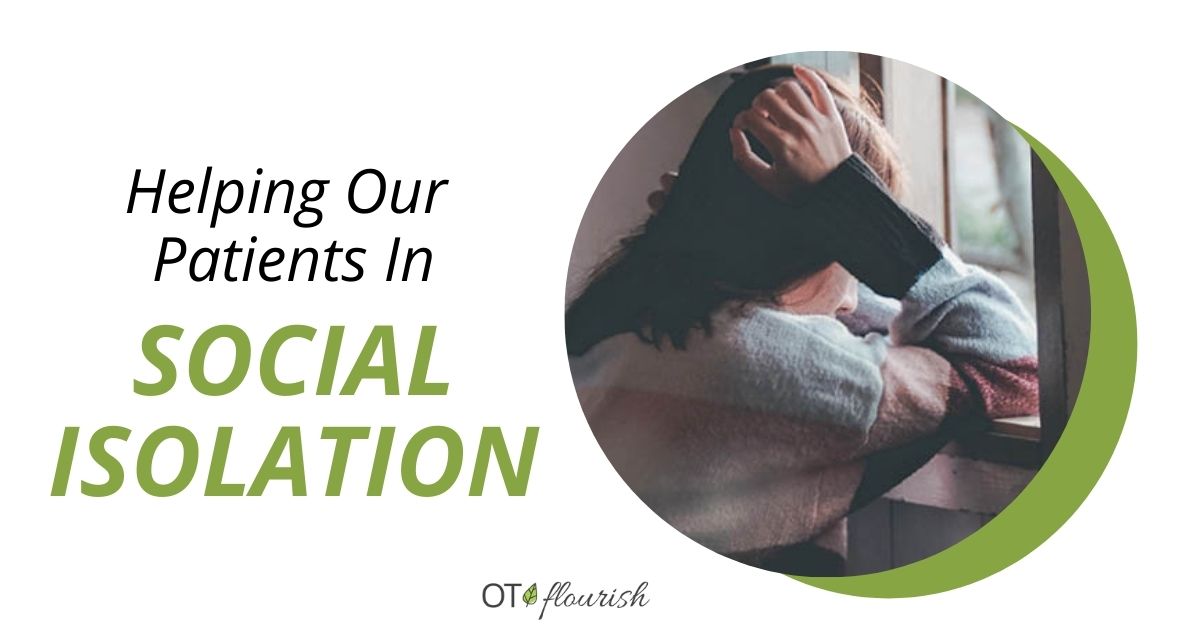Social Isolation for our older adult patients is hard. Heck, it is hard for everyone. As we reflect on the past few years (and I am not just talking about COVID-19), there are so many stories about how isolation and social distancing have contributed to our patients’ loneliness and having difficult times with finding meaning in the days 😔.
Even through we should be addressing mental health during our treatment sessions, it is more important than ever to support our patients to our best ability.
One thing that we, as occupational therapy practitioners (OTPs,) can do it help address the mental health of our elderly patients is see how it affects their lives and our therapy sessions, and what we can do as therapists to combat the negative effects (i.e. anxiety, depression, loneliness, etc.).
If you as a therapist have worked with elderly patients who are in isolation for infectious diseases or who live in a nursing home-type setting, then you already have a glimpse into what social distancing looks like for this population in absence of COVID-19. In 2014, Dr. Julian Rosen of geriatric psychiatry states that approximately 20% of residents in long-term care facilities have major depression and another 30% show depressive symptoms.
Some Of The Reasons For These Concerns About Social Isolation Include:
- Occupational deprivation
- Changes and reduction of self efficacy
- Limited social participation
- Disruption of roles, routines and habits
As occupational therapists, we already have several ethical responsibilities. Now more than ever, we have to up the ante regarding our practices and our clinical interactions with our elderly patients. This means doing so much more than the in-room upper-body therapeutic exercise regimen, but enabling occupational engagement with our patients and focusing on occupation based interventions.
I wanted to brainstorm some ideas on how not only can we, as OT practitioners, help with this through human connection and practical strategies. I am fully aware that these strategies will not “fix” the problem, but I fully believe that small changes can make compounding effects!
Let’s dig into things that you as an occupational therapy practitioner can do to prepare, as well as how to assist, your patients through this difficult time.
1. Be human and connect
Reflective responses and active listening
We all need to be listened to and research supports that active listening responses help people feel more understood than people who received advice or simple acknowledgements. Be sure to ask your patients how they are feeling today and genuinely listen. This may open a conversation into their current mental health and create a healthy conversation of support.
Listen with the intent to understand, not the intent to reply. – Steven Covey
Expressive touch
In a 2014 article by Douglas Morris, et al, expressive touch is identified as “warm, friendly physical contact and is not solely for performing a task. Expressive touch has been associated with improved client status, increased rapport and greater gains made during therapy.”
This can build trust and demonstrate compassion. Touch is integral part of human life and can bring comfort.

Therapeutic use of self strategies
Use your personality and strengths to truly connect with your patient. Actively listen, smile where appropriate, elicit genuine conversation, use humor, reveal common interests, etc. This strategy that should be interlaced in any therapy activities you choose to use.
Words of affirmation
There is MRI evidence suggesting that certain neural pathways are increased when people practice self-affirmation tasks (Cascio et al., 2016). Why not post some positive sayings using a post it note on your socially isolated patient’s bathroom mirror, on the closet or any other place that they would look at frequently?
Educate patient on how positivity can be used to squash negative self-talk and using these phrases can help with adaptation of these narratives to improve mood (as described through the self-affirmation theory).


A few examples include:
- I choose only to think good thoughts;
- I breathe, I am collected, and I am calm;
- I am safe, and I am cared for;
- This is just a period of time in life, it won’t last forever;
- Inside me, I feel calm, and nobody can disturb this peacefulness.
_______________________________________________________________________________________________________________________________________________________
Want a printable pdf list of 30 Positive Affirmations that you can use with your patients?
Sign up below and get access to this and all the resources available in the Free Level of the OT Accelerator


Make Good Samaritan visits at the end of the day
Be that healthcare worker – the one who takes an extra few minutes to check on their patients at the end of the day and be the bright spot
You don’t even have to go into each patient’s room. Just poke your head in for an end-of-the-day visit and confirm your future plans and visits for tomorrow. It shows your patients that someone cares, is there to support them and will help them on their healthcare journey.
2. Expand your “bag of tricks” for in-room therapy sessions.
We’ve listed a few activity ideas here that you can use with your patients during social distancing practices, but also have an entire blog post devoted to 55 in-room treatment ideas.
Mindfulness techniques:
Mindfulness in OT requires very little to no equipment and can be done from the comforts of the patient’s room. If you don’t know where to start, there are some great courses, like this one from MedBridge called, “Mindfulness to Cultivate Empathy, Resilience, & Therapeutic Presence.”
In bed or sitting yoga:
Another activity that requires very little equipment is yoga. Upgrade and downgrade yoga moves to meet your patient’s needs and goals (standing, sitting, supine, etc.).
Dance party:
Boogie down using your patient’s favorite music, which can be easily pulled up on a phone or I-Pad.
Self-feeding strategies:
If your patient has self-feeding goals, continue those strategies in the room. Safely sanitize and store all adaptive equipment in the patient’s room.


Pain management and modalities:
Continue modality uses with sanitation in mind if allowed through facility protocol. Store all used E-stimulation pads in the patient’s room. Clean all modality equipment before and after patient use. Don’t use cloth-based modalities (i.e. heating pads) if they can’t be readily cleaned after every use.
Get your patients outside:
Some facilities allow clinicians to help the patient’s get outside to perform therapy sessions as long as they are following administration protocol (which may include utilizing masks, staying 6 feet from any other staff/patient, etc). Sunshine is good for the soul!
![]()
![]()
Hygiene techniques and education for virus containment:
If your patient is very anxious about COVID-19, add some sanitation tips into their daily hygiene routine. Educate your patient about containment strategies, hand washing, coughing in their elbow, etc.
Technology education:
The internet was made for times like these. If your patient expresses an interest, make technology education a highlight in your sessions. Teach the patient about Zoom, Skype, Google Hangouts, social media use, virtual tours, online concerts, and online gaming so that they can still connect with the outside world. Additionally, teach your patient about internet safety.
If your patient is not able to interact through the internet due to cognitive ability, an idea would be for the family member and the patient to complete a “parallel activity” that they can do “together,” but separately. This will also engage in “normal” conversation besides the sometimes forced small talk.
A few examples include:
- completing different puzzles together
- both working on a craft such as knitting
- reading the newspaper, book or magazine out loud
- playing a game together such as Battleship


Limiting news exposure:
Even though our patients on social isolation deserved to be well-informed about what’s going on in the world, encourage your patients to take breaks from the news in order to limit anxiety and distress.
Phone calls schedules:
Communicate with loved ones in order to schedule regular phone calls with the patient. This can mean using the patient’s cellphone or scheduling times with nursing staff to use facility phones.
Church and religious practices:
If your patient would like to regular participate in church or religious services, introduce them to their online options such as virtual sermons or conferences. Talk to your facility about whether or not church leaders are permitted to visit for sacramental or blessing-related services. If not, arrange phone calls with church leaders.
Coloring books and workbooks:
Talk to your manager about purchasing inexpensive workbooks and coloring supplies for each patient to keep in their own rooms.
Writing letters/thank yous:
Work with your patients on writing letters. This can be to loved ones, to encourage interaction (and who doesn’t like to get mail?!), but they could also write thank you notes to nurses, kitchen, maintenance staff, etc.
Strategies For The OT Practitioner To Consider:
1. List out and assess your facility restrictions/policy changes – know what you are getting into
What are some new policies that there is no way of getting around that will immediately change your intervention strategies?
Common ones include:
- in-room visits only,
- no more group therapy sessions (or distancing sessions placing 6 feet or more between patients),
- in-room dining only,
- limiting manual therapy or tactile techniques, etc.
Keep track of and keep updated on all changes before beginning your sessions as many policies are changing as new research and best practices are modified.


2. Instill your new safety practices before interacting with your patients.
Make sure you are up-to-date in:
- sanitization methods for in room and equipment
- isolation procedures
- appropriate washing of scrubs, clothing, etc
3. Exploring why we went into OT in the first place
Many of us went into occupational therapy to help people. Help them engage in the occupations that enhance quality of life. Find this again. Find your “why” and really focus in on your therapeutic use of self to assist and emotionally connect with your patient.
We can do this!
As OTs, we are the next best thing to being friends and family to our patients when their regular visitors aren’t allowed. Let’s limit the negative effects by being optimal clinicians, as well as friendly human beings, for our residents and patients.
by Meredith D. Chandler OTR and Mandy Chamberlain MOTR/L









